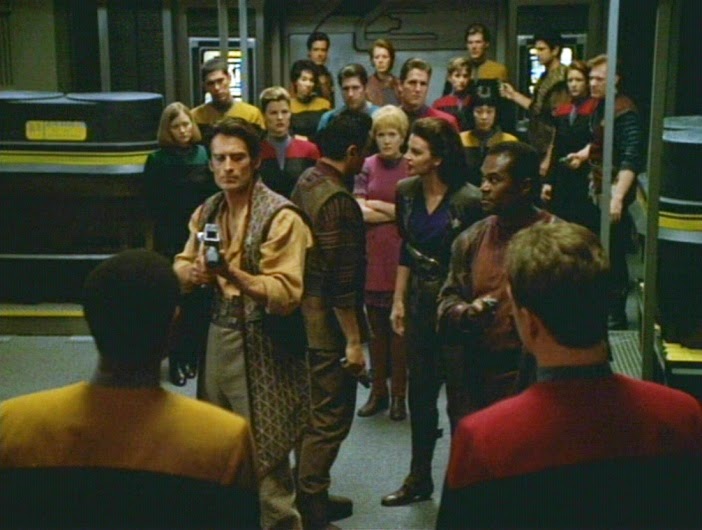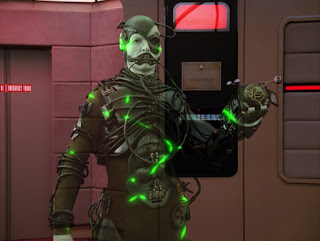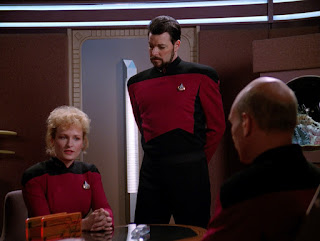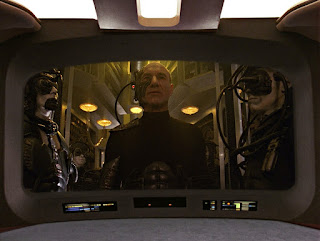Last week filming actually began on Star Trek Beyond.
 Not that you would have noticed. The first few days were particularly mute on a film that we also know virtually nothing about. Is it Klingons? Is it the five year mission? Will Idris Elba or Bryan Cranston be starring as villains? Is it none of the above?!
Not that you would have noticed. The first few days were particularly mute on a film that we also know virtually nothing about. Is it Klingons? Is it the five year mission? Will Idris Elba or Bryan Cranston be starring as villains? Is it none of the above?!
Frankly we know zip about this film. Potentially because Simon Pegg is still writing the script (or was the last time we had word from him). At least we know that it'll be called Beyond and that it commenced filming in the Canadian National Park on June 25th. Again Trekcore has some great pics of the possible filming location including some shots of very Star Trek fake rocks as well as platforms and a notice declaring that filming of something is taking place.
The cast themselves aside from Spock and Uhura have apparently been spotted in the area and we have the report that both Quinto and Pine have signed on for a fourth voyage. Good news that at least the movies are continuing for a few more years.
I'm not going into the whole conversation over speculation but Paramount have acquired the startrekbeyond.com website from the gent behind Star Trek Uncharted (formerly Beyond) who is getting the chance to pitch his series to the Powers That Be.
 What we do have is a couple of Instagram shots from Zachary Quinto getting ready to drop into character and Zoe Saldana prepping in her trailer. Then yesterday director Justin Lin dropped the first official photograph via his Twitter feed (left). So does this tell us anything about the production? Well it does confirm that they're making a third movie and that looks like some form of utility suit similar to the ones Kirk and McCoy were wearing at the beginning of Into Darkness when taking a swim back to the Enterprise.
What we do have is a couple of Instagram shots from Zachary Quinto getting ready to drop into character and Zoe Saldana prepping in her trailer. Then yesterday director Justin Lin dropped the first official photograph via his Twitter feed (left). So does this tell us anything about the production? Well it does confirm that they're making a third movie and that looks like some form of utility suit similar to the ones Kirk and McCoy were wearing at the beginning of Into Darkness when taking a swim back to the Enterprise.
One shot you might have missed was one (via Trekcore) which purported to show the Enterprise corridors being constructed in Vancouver. This is highly speculative and could even be a pic of the corridors being built for either of the previous productions. However, we can wish.
It's a very simple logo too - no central emblem denoting department but the blue might indicate Spock (as we know Quinto has started filming) science. But frankly that's about it. Heck I hoped there would be more but concrete facts on the movie are rarer than a sterilized tribble. In a way that's great since nothing's being ruined but might it suggest that the story isn't finished and they're still working out some of the "finer" details?
 I'll leave you to ponder over that one because talking of new Star Trek that Uncharted behemoth reared its head thanks to (I suspect) Michael Chang Gummelt owning a certain website name and having a very big series concept. I discussed my thoughts on a recent SFEscape Podcast and I'm not entirely comfortable with the format and the inclusion of the Stargate-like technology. I do find the exploration of a distant galaxy very intriguing and the backstory incredibly well thought out however there seem to be a lot of elements drawn from other sources and I need to be convinced more that this can still remain true to the principles of Star Trek. There is a great and varied array of characters as well as old and new races which would certainly expand and develop the franchise rather than restrain it within the 24th Century. I'd recommend casting your eyes over the site and certainly have a read of Michael's proposed pilot, Rendevous with Destiny. Which brings me neatly to another point.
I'll leave you to ponder over that one because talking of new Star Trek that Uncharted behemoth reared its head thanks to (I suspect) Michael Chang Gummelt owning a certain website name and having a very big series concept. I discussed my thoughts on a recent SFEscape Podcast and I'm not entirely comfortable with the format and the inclusion of the Stargate-like technology. I do find the exploration of a distant galaxy very intriguing and the backstory incredibly well thought out however there seem to be a lot of elements drawn from other sources and I need to be convinced more that this can still remain true to the principles of Star Trek. There is a great and varied array of characters as well as old and new races which would certainly expand and develop the franchise rather than restrain it within the 24th Century. I'd recommend casting your eyes over the site and certainly have a read of Michael's proposed pilot, Rendevous with Destiny. Which brings me neatly to another point. One show that does seem to have that century very much at it's core is Star Trek: The Next Generation, The Worf Chronicles. Aside from being a horrendous mouthful (may well abbreviate it to TWC in future) it does have some promise as Dorn's meetings with Paramount/CBS haven't ended with a definite 'No'. Following his recent AQA on reddit, the #wewantworf movement has certainly gathered interest both for and against with a rather bizarre yet original million mini-muffin campaign on the go to push studio executives in favour of the series. Certainly it'll have a big effect on their collestrol if nothing more.
One show that does seem to have that century very much at it's core is Star Trek: The Next Generation, The Worf Chronicles. Aside from being a horrendous mouthful (may well abbreviate it to TWC in future) it does have some promise as Dorn's meetings with Paramount/CBS haven't ended with a definite 'No'. Following his recent AQA on reddit, the #wewantworf movement has certainly gathered interest both for and against with a rather bizarre yet original million mini-muffin campaign on the go to push studio executives in favour of the series. Certainly it'll have a big effect on their collestrol if nothing more.
Strangely Dorn sees this as a way to flesh out the Worf character (finally) - but hang on, didn't he get more screen time and development than any other character EVER?!
OK, probably a minor issue that (!) but as a nice selling point, former Star Trek scribe Ronald D Moore has penned a pilot and it seems a few other stories should it get picked up. I've said it before, I say it again - do we need to keep going back here? I feel that the more people ask him about what happened to it, the more it feeds the veteran Star Trek actor and in turn that fuels the fan frenzy. It's a vicious circle which might lead to a show but (saying it again) Worf's been done to death and his rather sporadic later career left many of us somewhat confused as to where he was supposed to be after the conclusion of Deep Space Nine. Always seemed to be conveniently near the Enterprise didn't he?
I praise Dorn for getting the fans excited once again and it's good to see the community hyped up about the Prime Universe but I'm still thinking false hope and that, in some ways, Uncharted might stand more of a chance because it's fresh, set far enough distant from Voyager and the rest of the franchise and offers a new perspective on Star Trek. Sure I'll gripe about some of it's ideas but didn't we do the same when The Next Generation came along in 1987? Yes is the answer and I believe that if Uncharted - which is far from perfect - were made, we'd be in a similar situation. Worf is familiar, liked but a well-explored character while Uncharted does have the unexplored, frontier edge advantage plus 100% new characters, advanced tech and new species all in the mixing pot. Overall it's a much more enticing package although it doesn't have the initial might of a former Star Trek actor to add weight. That said, earlier this year Uncharted was barely known until it was forced into the name change and now look where it is.
Maybe just having the increased interest in renewing a TV path means we're more likely to get a new series. I'd like to think so. Where from? Still open to bidders I expect.
Liking Uncharted? Hating The Worf Chronicles? Found a better solution? Let us know below!










































